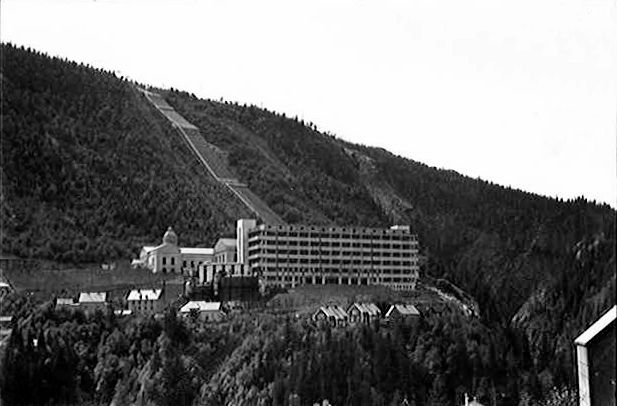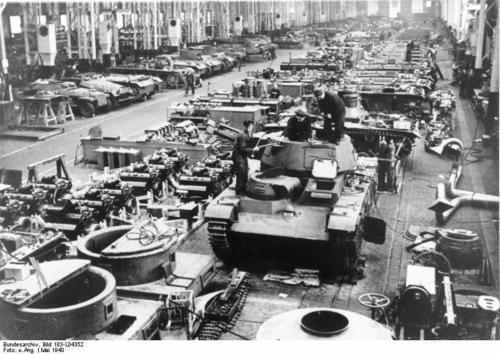Friday 3 May 1940
 |
| German troops and bombers on an improvised airfield during the battle for Norway, May 3, 1940 (Wide World Photo). |
In fact, the British arguably have a slight advantage in some ways in a Narvik campaign. The British Home Fleet not only completely outclasses anything that the Kriegsmarine can put in action, but its main base at Scapa Flow, Scotland is closer to Narvik than any German ports. Conceivably, the Allies could occupy northern Norway indefinitely - so long as nothing else comes up diverting scarce resources somewhere else.
King Haakon and the rest of the Norwegian government and Commander-in-chief Otto Ruge are under British protection just south of Navik at Tromsø. There is a 1000km (600 miles) buffer zone between them and the German troops further south.
The sense of hopelessness among the few active Norwegian forces remaining in the country is exacerbated by a radio broadcast by British Prime Minister Neville Chamberlain announcing the evacuation of Allied troops from the Trondheim region.
Norway Army Operations: The evacuation of British (1850) and French (2345) troops, along with some Norwegian troops and 30 Wehrmacht POWs, is finished before dawn. General de Wiart is grateful: "The Navy promised to evacuate my troops tonight. I thought it impossible, but the Navy does not know the word."
Colonel Ole Berg Getz—the Norwegian commander in the Trøndelag area - announces in his order of the day that he has proposed an armistice due to his lack of supplies, particularly ammunition. He broadcasts his surrender of troops in Nord-Trøndelag during the day and advises all other Norwegian forces in Trøndelag to do the same.
Norwegian General Jacob Hvinden-Haug throws in the towel and surrenders all troops south of Trondheim. All fighting south of Trondheim, in essence, is over except for holdouts.
The commander of one of those holdouts, Hegra Fortress, realizes from radio reports and its own situation that the end is at hand. Food is running out, and there is no hope of relief. The garrison begins destroying it artillery ammunition. Three Swedish volunteers are taken out of the fortress and escorted by a ski patrol to the Swedish border.
Norway Naval Operations: Destroyer HMS Afridi lingers at Namsos after the evacuation convoy leaves, shelling the dock and other port facilities before finally departing at 04:45.
The Allied troops evacuated from Åndalsnes arrive safely in Scapa Flow. The French transit to French passenger liners bound for Brest to aid in the defense of their own country.
Norway Air Operations: The Luftwaffe attacks the Namsos evacuation convoy at 09:45, sinking French destroyer Bison about 110 miles west of Vega Island, Norway at 10:10. There are 103 deaths - but many also wind up on HMS Afridi, which also goes down.
Afridi is bombed at 14:00 and also goes down quickly (45 minutes), with numerous deaths (45 crew, 13 men of 146th Brigade, and 30 of the 69 men just rescued from the Bison). Elderly General de Wiart - legendary escape-artist from hopeless predicaments - is forlorn: "I'm sorry I wasn't on board - I've missed a great experience!"
The Luftwaffe attacks British battleship HMS Resolution and Cruisers Aurora and Effingham off Narvik.
Western Front: Hitler is hard at work on Fall Gelb, the invasion of France and the Low Countries, and now is at the fine-tuning stage. He postpones the date from 5 May to 6 May, the small change showing how close the actuality is getting. He is assembling 93 Divisions along the border without the Allies apparently noticing.
Hitler sees the entire world up for grabs: "The earth is a challenge cup: it goes to those who deserve it.…"
French General Huntziger commands the 2nd Army on the Ardennes front. He is offended by the construction without his approval of anti-tank obstacles on two main roads through the forest and orders them demolished.
European Air Operations: The RAF bombs Oslo-Fornebu airfield, Stavanger-Sola, and Ry airfield in northern Denmark.
Three Luftwaffe fighters ambush a British reconnaissance plane over Borkum, losing one of their own numbers.
RAF bomber command sends 10 aircraft out on minelaying operations during the night. The Luftwaffe also conducts minelaying.
Convoy OA 141 departs from Southend, Convoy OB 141 departs from Liverpool.
Battle of the Atlantic: German commerce raider Atlantis is traveling in the south Atlantic disguised as Japanese freighter Kasii Maru. It spots British freighter Scientist near Walvis Bay on its way to Freetown, boards it, and then sinks it with a torpedo. There are three deaths.
Spies: Colonel Hans Oster of the German military intelligence service, the Abwehr, tells the Dutch military attaché in Berlin, Colonel Sas, that Fall Gelb is close, perhaps ready by 8 May. Unfortunately for Oster, his credibility has been undermined by previous postponements subsequent to his alerts. The neutral Dutch decide not to pass this information along to the Allies.
Applied Science: The Wehrmacht seizes control of the world's only heavy water production facility Vermork outside Rjukan in Tinn, Norway.
Greenland: The Danish crown colony takes a different route than Iceland, which earlier had declared independence. It seeks US protection to maintain its Danish sovereignty without German domination.
China: At the Battle of Tsaoyang-Ichang, the Japanese 11th Army captures Changshouien and Tienchiachi.
British Homefront: Industrialist Sir Alfred Edward Herbert, a huge advocate of women workers during World War I (along with minimum wages and maximum working hours), encourages women to sign up for factory work "at this grave time."
 |
| The Vermork hydroelectric plant in 1935. |
May 1940
May 1, 1940: British Leave ÅndalsnesMay 2, 1940: British Depart Namsos
May 3, 1940: Many Norwegians Surrendering
May 4, 1940: Bader Returns
May 5, 1940: HMS Seal Survives
May 6, 1940: Allies Focus on Narvik
May 7, 1940: In The Name of God, Go!
May 8, 1940: Exit Chamberlain
May 9, 1940: Enter Churchill
May 10, 1940: Fall Gelb
May 11, 1940: Eben Emael Surrenders
May 12, 1940: Germans at Sedan
May 13, 1940: Rommel at Work
May 14, 1940: German Breakout in France
May 15, 1940: Holland Surrenders
May 16, 1940: Dash to the Channel
May 17, 1940: Germans Take Brussels
May 18, 1940: Germans Take Antwerp
May 19, 1940: Failed French Counterattack
May 20, 1940: Panzers on the Coast
May 21, 1940: Battle of Arras
May 22, 1940: Attacking Channel Ports
May 23, 1940: British Evacuate Boulogne
May 24, 1940: Hitler's Stop Order
May 25, 1940: Belgian Defenses Creaking
May 26, 1940: Operation Dynamo
May 27, 1940: King Leopold Surrenders
May 28, 1940: The Allies Take Narvik
May 29, 1940: Lille Falls
May 30, 1940: Operation Fish
May 31, 1940: Peak Day for Dynamo
2019






